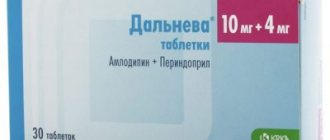Bisoprolol-Teva 5 mg No. 30 tablet.
Instructions for medical use of the drug Bisoprolol-ratiopharm Trade name Bisoprolol-ratiopharm International nonproprietary name Bisoprolol Dosage form Tablets, 5 and 10 mg Composition One tablet contains the active substance - bisoprolol hemifumarate 5 mg or 10 mg, excipients: lactose monohydrate, microcrystalline cellulose, Crospovidone (Kollidon CL), Yellow dye PB 22812**, Beige dye PB 27215**, magnesium stearate * - Current edition **Composition of yellow dye PB 22812: Lactose monohydrate - 87%, iron(II) oxide yellow E172 - 13% ** Composition of beige dye RV 27215: Lactose monohydrate – 60%, yellow iron(II) oxide E 172 -38%, red iron(II) oxide E172 – 2%. Description Round, biconvex tablets, pale with yellow spots, with an extruded number “5” and a score line on one side and smooth on the reverse side (for a dosage of 5 mg). Round, biconvex tablets, pale with beige speckles, with the number “10” extruded and scored on one side and smooth on the reverse side (for a dosage of 10 mg). Pharmacotherapeutic group Beta-blockers. Beta-blockers are selective. Bisoprolol. ATC code C07AB07 Pharmacological properties Pharmacokinetics Bisoprolol is almost completely absorbed from the gastrointestinal tract. The first pass effect in the liver is minimal, the bioavailability of bisoprolol is about 90%. Plasma protein binding is about 30%, volume of distribution is 3.5 l/kg. Total ground clearance is about 15 l/h. Half-life is 10-12 hours. Bisoprolol is excreted in two ways: 50% in the form of inactive metabolites by the liver, then excreted by the kidneys. The remaining 50% is excreted through the kidneys in unmetabolized form. Since excretion through the kidneys and liver is equal, there is no need for dose adjustment in patients with limited liver function or renal failure. The kinetics of bisoprolol is linear and does not depend on age. In patients with chronic heart failure (NYHA class III), plasma levels of bisoprolol are higher and the half-life is increased to 17 hours. Pharmacodynamics Bisoprolol-ratiopharm is a cardioselective beta-blocker without internal sympathomimetic activity and without membrane stabilizing effect. Bisoprolol significantly reduces plasma renin activity. Has local anesthetic properties. In patients with acute coronary syndrome without chronic heart failure, bisoprolol reduces heart rate and thereby cardiac output and oxygen consumption. With constant use of bisoprolol, the initially increased peripheral resistance in the vascular bed decreases. Indications for use - arterial hypertension - coronary heart disease - chronic heart failure Method of administration and dosage Bisoprolol tablets should be taken in the morning before, during or after breakfast, unchewed, with a small amount of liquid. Arterial hypertension and stable angina: The daily dose is 5-10 mg 1 time / day. Treatment should begin with the minimum dose (5 mg). The maximum daily dose is 20 mg. For patients with impaired renal function (creatinine clearance <20 ml/min), the dose should not exceed 10 mg once a day. Patients with severe hepatic impairment: No dose adjustment is required, although close monitoring is recommended. Elderly patients: Usually no dose adjustment is required. It is recommended to start with the lowest possible dose. Children under 18 years of age: There is no experience with these medications for children, so use cannot be recommended. Stopping treatment: Treatment should not be stopped abruptly. The dosage should be reduced slowly by halving the dose weekly. Chronic heart failure: Bisoprolol is prescribed in addition to existing therapy with ACE inhibitors, diuretics, and cardiac glycosides. Treatment begins with 1.25 mg once daily for 1 week, gradually increasing to 2.5 mg - 3.75 mg - 5 mg - 7.5 mg once daily at weekly intervals. The maximum recommended dose is 10 mg of bisoprolol once a day. After starting treatment with 1.25 mg bisoprolol, the patient should be monitored for a period of about 4 hours (particular attention should be paid to blood pressure, heart rate, impaired arousal ability, and signs of worsening heart failure). If necessary, the dose already achieved can also be gradually reduced. Treatment with bisoprolol should not be stopped abruptly, as this may lead to a temporary worsening of heart failure. If termination of treatment is necessary, the dose should be reduced in stages (for example, halving the dose at weekly intervals). Renal or hepatic insufficiency: dose increases should be carried out with extreme caution. Elderly patients: no dose adjustment is required. Children: There is no experience with bisoprolol therapy in children. For this reason, use for children cannot be recommended. Side effects Often - fatigue, weakness, feeling of dizziness, headaches (especially at the beginning of treatment) - Raynaud's phenomenon, increased existing intermittent claudication - nausea, vomiting, diarrhea, abdominal pain, constipation Sometimes - sleep disturbances, depression - bradycardia, AV disorders -conduction, worsening heart failure - orthostatic hypotension - bronchospasm in patients with bronchial asthma or a history of obstructive airway diseases - muscle weakness, cramps, arthropathy Rarely - nightmares, hallucinations - hearing loss - decreased lacrimation (must be taken into account if the patient wears contact lenses ) - hypersensitivity reactions (itching, flushing, exanthema) - allergic rhinitis, the appearance of antinuclear antibodies with unusual clinical symptoms, such as lupus syndrome, which disappear with the completion of treatment - hepatitis - potency disorders - increased levels of liver enzymes (ALAT, AST), triglycerides, hypoglycemia Very rarely - psoriasis or cause exanthema similar to psoriasis, hair loss. - conjunctivitis Contraindications - hypersensitivity to bisoprolol or one of the other components - acute heart failure or decompensated heart failure - cardiogenic shock - AV block II or III degree (without cardiac pacemaker) - sick sinus syndrome (Sick-Sinus-Syndrome) - sinoatrial block - bradycardia with less than 60 beats/minute before treatment - hypotension (systolic blood pressure below 100 mm Hg) - history of severe forms of bronchial asthma and chronic obstructive pulmonary disease - late stages of peripheral arterial occlusive disease or Raynaud's disease - untreated pheochromocytoma - metabolic acidosis - combinations with floctafenine and sultopride - simultaneous use of monoamine oxidase inhibitors (except MAO type B inhibitors) - galactose intolerance, Lapp lactase deficiency, galactose-glucose malabsorption - children and adolescents under 18 years of age - pregnancy and lactation period Drug interactions Contraindicated combinations Floctafenine: beta-blockers may interfere with compensatory cardiovascular responses, possibly caused by floctafenine hypotension or shock. Sultopride: Bisoprolol should not be used concomitantly with sultopride as there is an increased risk of ventricular arrhythmias. Not recommended combinations Calcium antagonists (verapamil, diltiacem): negative effects on contractility, atrioventricular conduction of excitation, and blood pressure. Clonidine and other centrally acting antihypertensive agents, such as methyldopa, guanfacine, moxonidine, rilmenidine: increased risk of “reverse hypertension”, excessive reduction in heart rate, and slowing of arousal conduction, including worsening heart failure. Monoamine oxidase inhibitors (except MAO-B inhibitors): increased blood pressure-lowering effect of beta-blockers, as well as the risk of hypertensive crisis. Combinations to be used with caution Class I antiarrhythmics (eg, disopyramide, quinidine): Possible increased effects on atrioventricular conduction time and negative inotropic effects (close clinical monitoring and ECG monitoring required). Class III antiarrhythmics (eg, amiodarone): Possible increased effects on atrial conduction time. Calcium antagonists (dihydropyridine derivatives): increased risk of hypotension. In patients with latent heart failure, heart failure. Cholinesterase inhibitors (including tacrine): possible increase in atrioventricular conduction time and/or increased bradycardia. Other beta-blockers, including those contained in eye drops: synergistic effect. Insulin and oral medications for diabetes: enhanced effect on lowering blood sugar levels. Beta-adrenergic receptor blockade may mask signs of hypoglycemia. Anesthesia: weakening of reflex tachycardia and increased risk of hypotension. Digitalis glycosides: slows heart rate, increases atrioventricular conduction time. Nonsteroidal anti-inflammatory drugs: decreased hypotonic effect. Ergotamine derivatives: increased peripheral circulatory disorders. Beta-sympathomimetic drugs (eg, isoprenaline, dobutamine): Combination with bisoprolol may result in a decrease in the effect of both drugs. Tricyclic antidepressants, barbiturates, phenothiazines, and other antihypertensive drugs: increased antihypertensive effect. Baclofen: Increased blood pressure lowering activity. Amifostine: Increased blood pressure lowering activity. Should be taken into account when used simultaneously! Mefloquine: increased risk of bradycardia. Corticosteroids: Reduce hypotonic effects by retaining water and sodium. Special instructions With caution: - impaired blood flow in the coronary vessels due to vascular spasm (Prinzmetal's angina) - peripheral occlusive lesions of the arteries - patients suffering from psoriasis or having a history of psoriasis. Allergic reactions: As with other beta blockers, bisoprolol may increase both sensitivity to allergens and the severity of anaphylactic reactions. In these cases, adrenaline may not always provide the desired therapeutic effect. Respiratory system: For bronchial asthma or other chronic obstructive dysfunctions that may be accompanied by symptoms, concomitant bronchodilator therapy is indicated. In rare cases, airway resistance may increase in patients with asthma, requiring increased doses of β2-sympathomimetics. General anesthesia: In patients who have received general anesthesia, beta blockers reduce the risk of arrhythmia and myocardial ischemia during induction of anesthesia, intubation and after surgery. It is currently recommended that beta blockers be continued perioperatively. The anesthesiologist should be informed that the patient is taking beta blockers, as there is a possible interaction with other drugs that can lead to bradyarrhythmias, decreased reflex tachycardia, and a decreased reflex ability to prevent blood loss. If it is necessary to discontinue beta-blocker therapy before surgery, it should be done gradually and be completed approximately 48 hours before anesthesia. Pheochromocytoma: In patients with pheochromocytoma, bisoprolol should be administered only after alpha blockade. Thyrotoxicosis: When treated with bisoprolol, symptoms of thyrotoxicosis may not be detected. The use of bisoprolol may lead to positive doping test results. Features of the effect of the drug on the ability to drive a vehicle or potentially dangerous mechanisms Bisoprolol-ratiopharm did not affect the ability to drive a car in a study of patients suffering from coronary heart disease. However, due to individual reactions, the ability to drive a car or work with technically complex mechanisms may be impaired. Particular attention should be paid to this at the beginning of treatment, after changing the dose, and also when consuming alcohol at the same time. Overdose Symptoms: bradycardia, hypotension, bronchospasm, acute heart failure and hypoglycemia. Treatment: gastric lavage or use of adsorbents (for example, activated carbon) and laxative (for example, sodium sulfate). For bradycardia, intravenous atropine. For hypotension - blood substitutes, vasoconstrictors. For bronchospasm: bronchodilator therapy (isoprenaline or beta-2 sympathomimetics). For AV block (II or III degree) - careful observation, isoprenaline infusions, or a temporary cardiac pacemaker should be installed. For hypoglycemia - intravenous administration of glucose. Release form and packaging 10 tablets in a blister pack made of polyvinyl chloride film and printed aluminum foil. 3 or 5 contour packages together with instructions for medical use in the state and Russian languages are placed in a cardboard box. Storage conditions Store at a temperature not exceeding 25ºС. Keep out of the reach of children! Shelf life: 3 years Do not use after expiration date. Conditions for dispensing from pharmacies By prescription Manufacturer “Merkle GmbH”, Germany Owner of the registration certificate “ratiopharm GmbH”, Germany Address of the organization that accepts claims from consumers on the quality of products (products) in the territory of the Republic of Kazakhstan Ratiopharm Kazakhstan LLP, Almaty , Al-Farabi Ave., 19, BC “Nurly-Tau”, 1B, off. 603, Phone: (727)3110915, Fax: (727)3110734, e-mail

